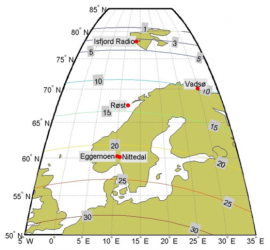|
This ESA funded project Ka-band Radio characterisation for SatCom services in arctic and high latitude regions performs a long-term study of Ka-band propagation effects in arctic and high latitude regions. It is believed that the outcome of this study can be used to further refine and enhance the relevant ITU-R radio wave propagation models for geostationary orbiting satellites serving high latitude low elevation angle locations on land, coastal areas, and at sea.
The high latitude Northern European areas are of increasing value due to natural resources such as fishing industry and oil/gas exploration. The arctic is of crucial importance as the potential climate effects opens up frozen sea parts for longer periods of the year. Reliable communication systems to cover these regions can only realistically be delivered by satellites. Svalbard has already proven to be a highly suitable location for downloading data from polar orbiting Earth observations satellites.
A SatCom Ka-band system is particularly attractive for broadband data serving business and applications as mentioned. Telenor Satellite Broadcasting (TSBc) have decided to invest in new geostationary satellites services, including the launch of Thor 7 in April 2015, providing data services in Ka-band.
The experimental campaign aims at defining the radio channel characteristics relevant for the design and the performance assessment of a radio link, including:
- aid the satellites payload design for Ka Band satellites in high latitude regions
- helps in the overall satellite system dimensioning
- provides measurements of rain attenuation in high latitudes
- measures propagation effects, such as gaseous attenuation, scintillation, scattering, and ducting
|
| About
|
|
This ESA funded project aims at performing a long-term study of Ka-band propagation effects in arctic and high latitude regions

|
People
|
Participating Partners
|
ESA project manager
(edit)
|
|

